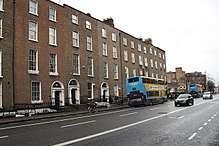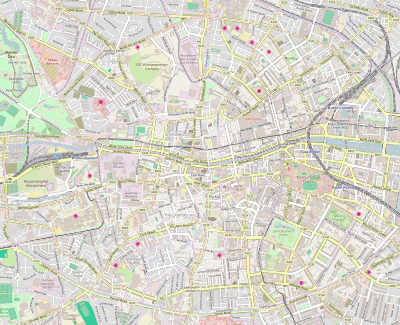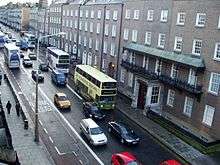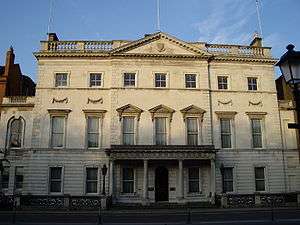Leeson Street
Leeson Street (/ˈliːsən/; Irish: Sráid Líosain) is a thoroughfare near central Dublin, Ireland. The street is divided into two parts by the Grand Canal: Lower Leeson Street, in Dublin 2 is to the north of the canal, linking to St Stephen's Green, with Upper Leeson Street, in the Dublin 4 region, south of the canal. Originally known as Suesey Street, it was renamed in 1728 after the Leesons, a family of local brewers, who branched into property development and subsequently became Earls of Milltown. In 1767 a Magdalen Asylum was established by Lady Arabella Denny in the street for Protestant women.[1]
 Lower Leeson Street | |
 | |
| Native name | Sráid Líosain (Irish) |
|---|---|
| Namesake | Joseph Leeson, 1st Earl of Milltown |
| Length | 1.3 km (0.8 mi) |
| Width | 23 metres (75 ft) |
| Location | Dublin, Ireland |
| Postal code | D02, D04 |
| Coordinates | 53°20′00″N 6°15′16″W |
| northwest end | St. Stephen's Green (southeast corner), Earlsfort Terrace |
| southeast end | Morehampton Road |
| Other | |
| Known for | prostitution, cafés, Catholic University School, Institute of Education |
.jpg)
The street is home to several prominent buildings including the main office of the Ombudsman and the embassies of Portugal, Malta, and Cyprus.[2] The largest building on Lower Leeson Street, along with several adjoining buildings and significant land holdings in the area, is owned by the Catholic University School.
In 1990, Caravaggio's lost masterpiece, The Taking of Christ, was recognised in the residence of the Jesuit Communication Centre on Lower Leeson Street.[3][4] Broadcaster Gerry Ryan lived and died on this street.[5]
Leeson Street is a notorious red-light district, and has been since the 18th century, when the first Magdalene Asylum opened on the street for "penitent" prostitutes.[6][7] There were formerly large numbers of streetwalkers but prostitution in Ireland has moved online in recent years.[8][9][10][11][12]
Gallery
 Lower Leeson Street junction with Earlsfort Terrace and St Stephen's Green
Lower Leeson Street junction with Earlsfort Terrace and St Stephen's Green Bus lane on Lower Leeson Street
Bus lane on Lower Leeson Street Upper Leeson Street
Upper Leeson Street Upper Leeson Street
Upper Leeson Street Grand Canal at Leeson Street Bridge
Grand Canal at Leeson Street Bridge Iveagh House, adjacent to Lower Leeson Street
Iveagh House, adjacent to Lower Leeson Street
References
- Kilfeather, Siobhán Marie (2005). Dublin: A Cultural History. New York: Oxford University Press. p. 258. ISBN 978-0-19-518202-6.
- About us, Office of the Ombudsman
- Walshe, Elaine (2013–14). "A Picture Of Mystery". The Irish Letter. Retrieved 6 January 2015.
- "The Taking of Christ, Caravaggio". National Gallery of Ireland. 16 October 2014. Retrieved 6 January 2015.
- "Gerry Ryan found dead". Irish Examiner. 30 April 2010. Retrieved 30 April 2010.
- "Prostitution in Ireland | History Today". www.historytoday.com.
- Luddy, Maria (December 1, 1997). ""abandoned women and bad characters": prostitution in nineteenth-century Ireland". Women's History Review. 6 (4): 485–504. doi:10.1080/09612029700200157.
- "D4 suburb complain of prostitutes". Breaking News. September 23, 2007.
- "Dublin Red Light District".
- "Drug habits force women to keep working the streets". www.irishexaminer.com. January 23, 2007.
- "I was a teenage prostitute – but I turned my life around for my son". independent.
- Hennessy, Michelle. "Nineteenth anniversary of the disappearance of Trevor Deely". TheJournal.ie.